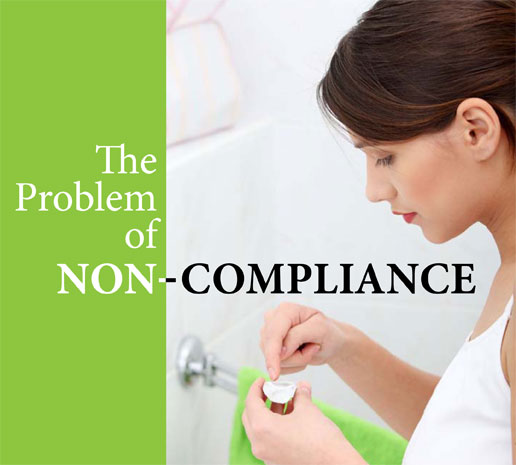By Shirley Ha, BSc. (Hons), O.D.
Despite growing awareness that improper contact lens care and wear procedures can significantly increase the risk of eye infections, many consumers still do not follow the manufacturer or practitioner’s recommendations for safe practices.
According to a University of Texas survey of 433 contact lens wearers, more than 50 per cent of participants were able to name contact lens-related complications. Yet only 2 per cent demonstrated ‘good’ compliance and only 1 participant was ‘fully’ compliant. At the same time, 85 per cent of participants believed they practiced safe lens, solution and case handling.[i]
The non-compliant behaviors cited were:
- Swimming (64 per cent) and exposure to tap water, including showering (57 per cent) while wearing lenses
- Sleeping while wearing lenses not intended for continuous wear (56 per cent)
- Failure to adhere to the recommended wearing schedule (52 per cent)
- Not washing hands prior to handling lenses (49 per cent)
- Never replacing lens case or replacing them only if given a new case (47 per cent)
- Topping up (42 per cent) or re-using (28 per cent) disinfectant solutions
Interestingly, ‘comfort and handling’ was cited as a complication more often than infection – and although 90 per cent of study participants were aware of the importance of using fresh solution, many failed to discard used solution first.
In another study, 20 per cent of patients polled in the UK admitted that they used tap water, saliva, baby oil, beer, Coke, petroleum jelly, lemonade, fruit juice and butter (!) as alternatives to contact lens solutions (Bausch + Lomb news release, Nov. 2011).
In recent years, a plethora of industry-sponsored research papers have discussed contact lens care compliance relating to solutions, wearing modality and ocular lubricants.[ii] However, in developing safer, more effective and easier-to-use disinfection systems and more comfortable, oxygen-permeable lenses, manufacturers could inadvertently be sending a false message that it is ‘safe’ to stretch lens wear longer than indicated or to sleep in lenses more often than recommended.
In comparison with these findings, about 350 eyecare practitioners surveyed by Contact Lens Spectrum for the 2011 Annual Contact Lens Report believed that 75 per cent of their patients wash their hands before handling their lenses, that 60 per cent rub their lenses and 64 per cent rinse them as recommended; they also believed that 70 per cent of their patients followed recommended contact lens hygiene guidelines.[iii]
So, why the discrepancy between practitioner perception and patient performance? Are patients lying to their practitioners about lens hygiene and solution handling?
To cultivate compliance, the gold standard has always been to use auditory and visual patient education aids to address personal hygiene or hand washing, wearing and replacement schedule[iv],[v] , cleaning and disinfection of lenses and storage cases , and to discuss adverse contact lens-related events such as potential corneal complications. Yet, a significant majority of patients continue to demonstrate non-compliance despite awareness of the risks.[vi]
Dr. Gary Gerber, a New Jersey-based practice building expert-optometrist and president and founder of Power Practice®, agrees that not all aspects of patient education work to improve compliance: « We know that showing patients an ulcerated cornea or the classic nasty red eye poster doesn’t work. Education about what patients lose when they are non-compliant resonates better. So, talk to patients about the reasons they love wearing lenses (freedom, self-confidence) and remind them that if they blow it, they lose all that. In other words, talk about the loss of benefits and advantages – not the features of the lenses.”
It remains incumbent on practitioners to keep providing appropriate patient education, instruction and training in order to increase patient vigilance about the risks associated with contact lens wear. Equally important are regular follow-up visits to determine whether they are compliant with the recommended wearing and replacement schedule and to ascertain whether patients are conforming to the accepted lens, solution and lens case care guidelines.
Standardizing a set of questions to elicit non-compliant behaviors and repeating professional advice at each follow-up visit can help practitioners augment compliance and reinforce the importance of good lens and solution handling practices. Be aware that the questions, depending on how they are formulated, may also generate false responses from patients, especially from those who don’t want to admit to improper lens wear and care. As an example, ask patients what happens in the morning after they have slept in their lenses instead of asking whether they sleep overnight in their lenses.
Not all contact lens-related problems are the result of poor compliance and there is no quick fix for patient non-compliance. The problem is not going to disappear anytime soon but by recognizing the different kinds of non-compliant behaviors, providing appropriate education and training, asking the right questions at follow-up visits, and delivering the consistent message of continued commitment to good lens, solution and lens case hygiene, practitioners can help carve a safe and healthy path to clean, clear and comfortable vision for all contact lens patients.
[i] ROBERTSON, DM, CAVANAGH, HD. Non-Compliance with Contact Lens Wear and Care Practices: a Comparative Analysis Optometry & Vision Science, December 2011, volume 88, pp1402-1408
[ii] GROMACKI, SJ. Research From the 2011 AAO Annual Meeting, Contact Lens Spectrum, December 2011
[iii] NICHOLS, JJ. Contact Lenses 2011, Contact Lens Spectrum, January 2012
[iv] HICKSON-CURRAN, SB. Compliance Before, During and After Contact Lens Wear, Contact Lens Spectrum, January 2012
[v] BENOIT, DP. Compliance and Contact Lenses, Contact Lens Spectrum, May 2011
[vi] BUI, TH, CAVANAGH, HD, ROBERTSON, DM. Patient Compliance During Contact Lens Wear: Perceptions, Awareness, and Behavior., Eye & Contact Lens, November 2010, volume 36, issue 6








